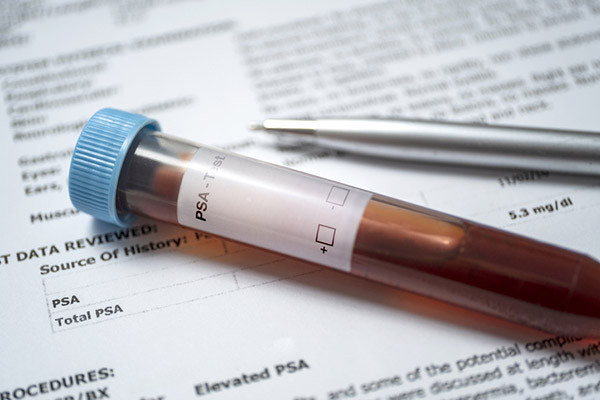How does waiting on prostate cancer treatment affect survival?
An important clinical trial shows that many patients can delay it safely for years.
- Reviewed by Marc B. Garnick, MD, Editor in Chief, Harvard Medical School Annual Report on Prostate Diseases; Editorial Advisory Board Member, Harvard Health Publishing

Prostate cancer progresses slowly, but for how long is it possible to put off treatment? Most newly diagnosed men have low-risk or favorable types of intermediate-risk prostate cancer that doctors can watch and treat only if the disease is found to be at higher risk of progression. This approach, called active surveillance, allows men to delay — or in some cases, outlive — the need for aggressive treatment, which has challenging side effects.
In 1999, British researchers launched a clinical trial comparing outcomes among 1,643 men who were either treated immediately for their cancer or followed on active surveillance (then called active monitoring). The men's average age at enrollment was 62, and they all had low- to intermediate risk tumors with prostate-specific antigen (PSA) levels ranging from 3.0 to 18.9 nanograms per milliliter.
Long-term results from the study, which were published in March, show that prostate cancer death rates were low regardless of the therapeutic strategy. "This hugely important study shows quite clearly that there is no urgency to treat men with low- and even favorable intermediate-risk prostate cancer," says Dr. Anthony Zietman, the Jenot W. and William U. Shipley Professor of Radiation Oncology at Harvard Medical School, anda radiation oncologist at Massachusetts General Hospital who was involved in the research and is a member of the Harvard Medical School Annual Report on Prostate Diseases editorial board. "They give up nothing in terms of 15-year survival."
What the results showed
During the study, called the Prostate Testing for Cancer and Treatment (ProtecT) trial, researchers randomized 545 men to active monitoring, 533 men to surgical removal of the prostate, and 545 men to radiation.
After a median follow-up of 15 years, 356 men had died from any cause, including 45 men who died from prostate cancer specifically: 17 from the active monitoring group, 12 from the surgery group, and 16 from the radiation group. Men in the active surveillance group did have higher rates of cancer progression than the treated men did. More of them were eventually treated with drugs that suppress testosterone, a hormone that fuels prostate cancer growth.
In all, 51 men from the active surveillance group developed metastatic prostate cancer, which is roughly twice the number of those treated with surgery or radiation. But 133 men in the active surveillance group also avoided any treatment and were still alive when the follow-up concluded.
Experts weigh in
In a press release, the study's lead author, Dr. Freddie Hamdy of the University of Oxford, claims that while cancer progression and the need for hormonal therapy were more limited in the treatment groups, "those reductions did not translate into differences in mortality." The findings suggest that for some men, aggressive therapy "results in more harm than good," Dr. Hamdy says.
Dr. Zietman agrees, adding that active surveillance protocols today are even safer than those used when ProtecT was initiated. Unlike in the past, for instance, active surveillance protocols now make more use of magnetic resonance imaging (MRI) scans that detect cancer progression in the prostate with high resolution.
Dr. Boris Gershman, a surgeon who specializes in urology at Harvard-affiliated Beth Israel Deaconess Medical Center, and is also an Annual Report on Prostate Diseases editorial board member, cautions that the twofold higher risk of developing metastasis among men on active surveillance may eventually translate into a mortality difference at 20-plus years.
"It's important to not extend the data beyond their meaning," says Dr. Gershman, who was not involved in the study. "These results should not be used to infer that all prostate cancer should not be treated, or that there is no benefit to treatment for men with more aggressive disease." Still, ProtecT is a landmark study in urology, Dr. Gershman says, that "serves to reinforce active surveillance as the preferred management strategy for men with low-risk prostate cancer and some men with intermediate-risk prostate cancer."
Dr. Marc B. Garnick, the Gorman Brothers Professor of Medicine at Harvard Medical School and Beth Israel Deaconess Medical Center, and editor in chief of the Annual Report, points out that nearly all the enrolled subjects provided follow-up data for the study's duration, which is highly unusual for large clinical trials with long follow-up. The authors had initially predicted that patients from the active monitoring group who developed metastases at 10 years would have shortened survival at 15 years, "but this was not the case," Dr. Garnick says. "As with many earlier PSA screening studies, the impact of local therapy on long-term survival for this class of prostate cancer — whether it be radiation or surgery — was again brought into question," he says.
About the Author

Charlie Schmidt, Editor, Harvard Medical School Annual Report on Prostate Diseases
About the Reviewer

Marc B. Garnick, MD, Editor in Chief, Harvard Medical School Annual Report on Prostate Diseases; Editorial Advisory Board Member, Harvard Health Publishing
Disclaimer:
As a service to our readers, Harvard Health Publishing provides access to our library of archived content. Please note the date of last review or update on all articles.
No content on this site, regardless of date, should ever be used as a substitute for direct medical advice from your doctor or other qualified clinician.















